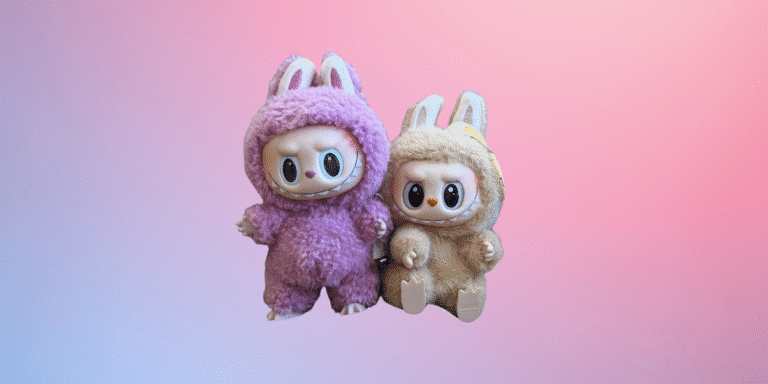I stood on the street in front of Miniso — a cutesy store with Hello Kitty plushes in the windows and rows of blind boxes lined up neatly on the shelves — and the message hit me before I could even open the door: We do not sell Labubu. A Labubu was right there on the sign, looking at me with a pointy-toothed smirk, as if it was saying, “Just try and find me.” I could not.
For those who have not yet crossed paths with these elven monsters, Labubus are the hottest collectibles of the moment. With long, rabbit-like ears, fuzzy bodies and menacing grins filled with sharp teeth, they straddle that perfect line between cute and not-cute. (Think mischievous but harmless, like Stitch.) They’ve been released in more than 300 colors, shapes and sizes, as everything from blind boxes to big plushes, but the soft bag charm seems to be the most desired in the line. Fans from teens to adults are in a frenzy over them, and yet at Good Housekeeping we can’t even include them in our gift guides because they sell out too quickly.
And while Labubus are the “chase” item of the moment, the characters trace their origin back to 2015. Kasing Lung, an artist from Hong Kong, created them for a story series called “The Monsters.” In 2019, Lung partnered with collectibles company Pop Mart to license his creations. (According to Lung, “Labubu” is the collective name of the elven species. Individual Labubus have their own names and characteristics, but they all have one thing in common: All Labubus are female.) The collections took off, and Blackpink’s Lisa, Dua Lipa, Rihanna, Emma Roberts, David Beckham and other celebrities have been seen out and about with their Labubus, often dangling from designer bags.
It’s hard to state just how popular they’ve become. “I’ve been here for a little over seven years, and in my time monitoring the collectible space, I have really seen nothing like this,” says Drew Haines, the merchandising director of sneakers and collectibles at StockX, a secondary resell site where people go hunting for Labubus when, like me, they can’t find them in stores. “It’s just unprecedented. Every time I think it’s sort of at its peak, it takes on another level of cultural influence. I’m seeing NBA players walk in with Labububs on their belt loops.”
Haines notes that when the Labubu “Big Into Energy” series came out, it was the No. 1 best release-day performance for a non-sneaker on StockX, beating out the PlayStation 5. “The product released in the United States at 10 pm,” he adds. “You would think that there wouldn’t be enough time for it to break that record. We saw thousands and thousands of orders come in just during that two-hour window.”
“Honestly, I think what’s happening here is bigger than toys,” says Jane Buckingham, CEO of the trend-forecasting company Trendera. “Gen Z is building these emotional ecosystems around small things. Whether it’s Labubu or an advent calendar or a $12 lipstick, it’s about making meaning out of little moments. Also, there’s something powerful in how these things create community. People share what they’re opening, what they got, what they’re hoping for. It becomes this fun, low-pressure way to connect.”
This all fits in with my personal theory that we’re living in a “little treats” economy, where people rely on these trinkets pick-me-ups to get them through the drudgery of adulting. Buckingham says she’s seeing the same. “Gen Z and Millennials are often more about allowing themselves little treats since they don’t know if they will ever be able to afford the bigger success symbols like a house or nice car,” she says. “But they can afford a $20 to $40 Labubu at Pop Mart. It’s small, it’s cute, it feels like a reward. Right now, people are looking for those small moments of happiness. And they’re savvy enough to know that that small moment of happiness might even lead to a bigger payoff!”
“Gen Z and Millennials are often more about allowing themselves little treats since they don’t know if they will ever be able to afford the bigger success symbols like a house or nice car. But they can afford a $20 to $40 Labubu at Pop Mart.”
The question is, how high can the price tag go for something to still count as a “little treat?” Already, Labubu is starting to see the price of popularity. A pendant blind box from the Labubu Big Into Energy series initially cost $27.99 at Pop Mart, which is already more expensive than other trendy collectibles, like Sonny Angel, which starts at $11.25 for a blind box. Now that it’s sold out, the price has risen to around $50 on StockX or on Ebay. Rarer colors and releases go for much higher. If the prices rise even more, due to scarcity, speculation or — ugh — tariffs, will Gen Z and Millennials be priced out of their little moments of joy?
Haines says he trusts Pop Mart to keep the prices at a level that will keep fans buying. “Pop Mart as a brand has always been at that price point going back many years,” he says. “So I don’t think that they’re going to all of a sudden raise prices, or that the secondary market would take off to the point where these are now $200 for an individual keychain even in the common colors.”
And even if they’re more expensive than a Sonny Angel, they’re still less expensive than other luxuries.
The bigger threat, then, is if the frenzy sucks the fun out of collecting. “If the price jumps because of tariffs or hype, I think a lot of casual collectors would drop off,” Buckingham says. “With Cabbage Patch Kids and Beanie Babies, part of the appeal was that scarcity. But those also got kind of toxic. Once it becomes more about resale value than joy, or people competitively saying yours is ‘not a good one,’ people start to check out. Labubu works because it feels light and accessible. If you mess with that too much, the whole vibe changes. And if the hype is so big that everyone’s mom or grandma is sporting a Labubu, chances are the Gen Zs will move off of it to claim something else for themselves.”
This is why — though I love a good treat, and though every zipper of every backpack in my house is decorated with some kind of dangling doodad — for now, my family remains Labubu-less. I just can’t justify that price for a bag charm, and even if I could, I wouldn’t be able to find one. But when I look around the New York City subway, there are plenty of fiendish creatures smiling back at me, saying, “Come and get me.”

Marisa (she/her) has covered all things parenting, from the postpartum period through the empty nest, for Good Housekeeping since 2018; previously, she wrote about parents and families at Parents and Working Mother. She lives with her toy-collecting husband and daughter in Brooklyn, where she can be found helping out her team at bar trivia or posting about movies on Twitter and Bluesky.




